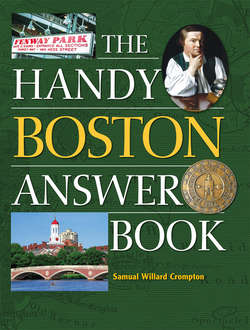Читать книгу The Handy Boston Answer Book - Samuel Willard Crompton - Страница 14
На сайте Литреса книга снята с продажи.
THE FIRST GOVERNMENT
ОглавлениеDid the Puritans of Boston establish a democracy, a theocracy, or an oligarchy?
This is one of the great and controversial questions with no definitive answer. Some historians argue that the Puritans quickly established a theocracy, a system in which the ministers or priests ruled. Others contend that Boston was really an oligarchy, a system in which the wealthy—merchants especially—dominated. Still others examine the same set of data and conclude that Boston was more democratic than almost any other town among the early American colonies.
The best answer is that the Puritans believed in a system of hierarchy: they were not democrats. It made perfect sense to them that their rulers would come from the better educated and wealthier men, and it does not seem to have occurred to any of them that women might one day gain the right to vote. Because the Puritans were ardent churchgoers, ministers naturally played an important role. But the Puritans were early believers in separation between church and state. Magistrates—meaning secular officials elected by the people—were just as important as ministers.
What was the name and shape of the early government in Boston?
By 1634 the Boston Puritans had established the Great and General Court of the Colony of Massachusetts Bay, and with only a few alterations, this remains the expression used to describe the Massachusetts legislature of today. The Great and General Court was composed of a governor—elected by the freeholders (part-time legislators)—a governor’s council (chosen by the governor), and a House of Representatives. The Puritans placed all three together in a figurative sense and called it the Great and General Court.
For a handful of years, Boston was the only town in the colony, but as other areas were established (Newtown was the first) it became necessary to differentiate the government of the town of Boston from that of the colony. Boston held its first town meetings in the 1640s, and the New England form of town meeting was thereby born: a day in May was usually the time when the freeholders met to discuss and vote on articles brought before them by the town selectmen. To the best of our knowledge, Boston and Massachusetts politics were rather fractious, right from the beginning.
Did one have a sense in the 1630s that the Massachusetts Puritans might one day break away from Old England?
Yes. The English officials that came to examine Boston—and they were few in number—remarked on the independent quality of the Bostonians and their country cousins. In 1676 the governor of Massachusetts commented to an English customs inspector that the laws of Old England were bounded by the Four Seas—meaning the English Channel, the North Sea, the Irish Sea, and the North Atlantic—and did not apply to the American colonies. Even if inspector Edward Randolph exaggerated it a bit in the telling, there is little doubt that the Puritans regarded themselves as a people set apart with a great destiny. This idea is also reflected in the words of John Winthrop’s famous sermon in which he described the mission of the colonists as follows: “we shall be as a city on a hill.”
Did the early Bostonians have any trouble earning a living?
Cash—in the sense of copper and silver coins—was rarely used and the early settlers worried much more about getting in their supply of cord wood for the winter (this was difficult because the trees of Shawmut peninsula disappeared very quickly). But over the next four decades, Bostonians discovered more need for cash, and in 1653 mint master John Hull made the first “Pine Tree Shillings.” A truly New England currency, these shillings provoked much concern among British officials, who claimed that the Bostonians wanted to be independent in all but name.
The Mayflower Compact, signed aboard the ship of that name, established the pattern for Pilgrim and Puritan self-government.
Earning a living in early Boston usually meant doing something connected with the waterfront. Bostonians built docks and wharves at an incredible rate, and their ships commenced a trade with the West Indies (Caribbean) by the 1650s.
Blessing of the Bay was the first ship built in Boston; it was followed by dozens of others. Boston also provided a number of truly expert sailing masters, who made all sorts of transatlantic voyages. It’s hard to pick out just one, but Master John Balston, a second-generation Bostonian, turns up in the records time and again. His family were natives of England’s West Country, and they may have navigated the shores of Devon and Cornwall long before coming to America. All we can say for certain is that Balston made the trip from Boston to London, and from Boston to Plymouth, England, a great number of times.
How did outsiders view Boston and its new merchant community?
One of the best descriptions of mid-seventeenth-century Boston comes from the pen of John Josselyn, an Englishman who traveled to the colonies twice and wrote an extensive commentary on his travels.
The town hath two hills of equal height on the front part thereof next the sea, the one well fortified on the superficies with some artillery mounted, commanding any ship as she sails into the harbor.… The houses are for the most part raised on the sea-banks and wharfed out with great industry and cost, many of them standing upon piles, close together on each side the streets as in London.… The town is rich and very populous, much frequented by strangers, here is the dwelling of their governour. On the North-west and North-east two constant fairs are kept for daily traffic.
Proc. Mass Historical Society, Vol III, 3rd Series, Cambridge, 1833, p. 319
